It looks like you're using an Ad Blocker.
Please white-list or disable AboveTopSecret.com in your ad-blocking tool.
Thank you.
Some features of ATS will be disabled while you continue to use an ad-blocker.
share:
Frederic Norden during the 1700's in his book 'Travels in Egypt and Nubia' described a fourth Giza main pyramid, his illustrations regarding the
position of such are very good for the period,
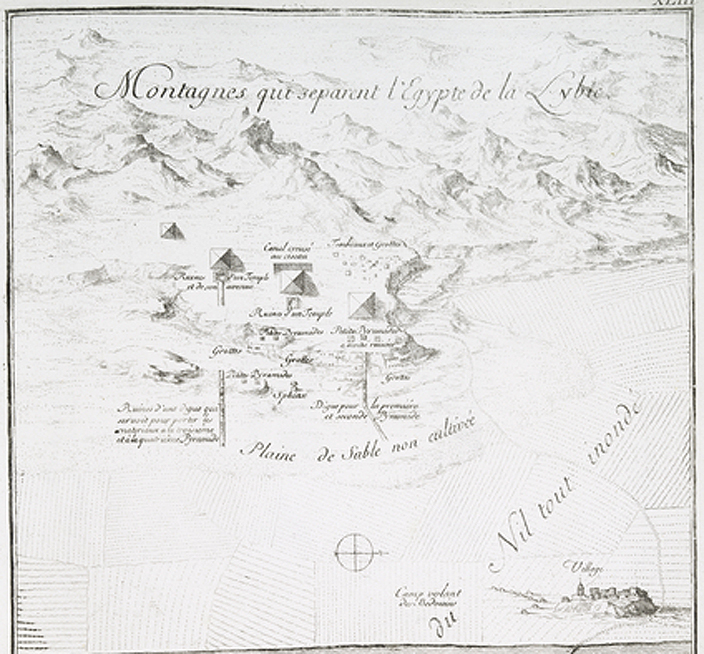
He describes this pyramid here page 120;
Travels in Egypt and Nubia
Other early illustrations also show this fourth pyramid;
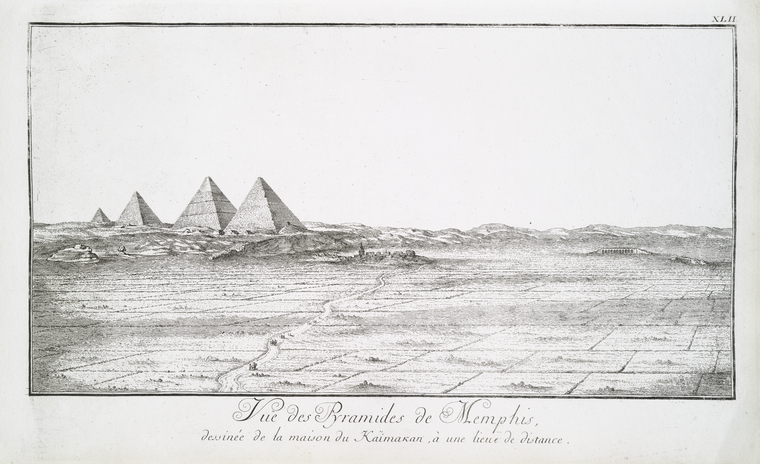
The suggestion tends to be dismissed in terms of considering he mistakenly took one of the satellitie pyramids of Menkaure as a fourth pyramid, though he describes the pyramid as made of a stone blacker and harder than granite, whereas the satellite pyramids are all sandstone, also his site plan is of very good quality for the period and positions the fourth pyramid some distance away from that of the third.
He does describe seven or eight lesser pyramid constructions also, which would incorporate the satellite pyramids and show that he did take these into account.
A suggestion is that this fourth pyramid was quarried in the late 1700's, but that there are still stones/ruins in its former locale
Here are some site plans and diagrams that have attempted to incorporate this fourth black pyramid into the greater Giza scheme of things;
www.lostchord.org...
www.lostchord.org...
www.lostchord.org...
There has been a history channel documentary regarding a lost fourth pyramid of Giza, but that was just about the Djedefre pyramid which was never lost anyway, the one that Norden described and placed on his diagram truly has been...
Here's a satellite photo of the area West of G3/Menkaure, some see evidence for an enclosure and square base.
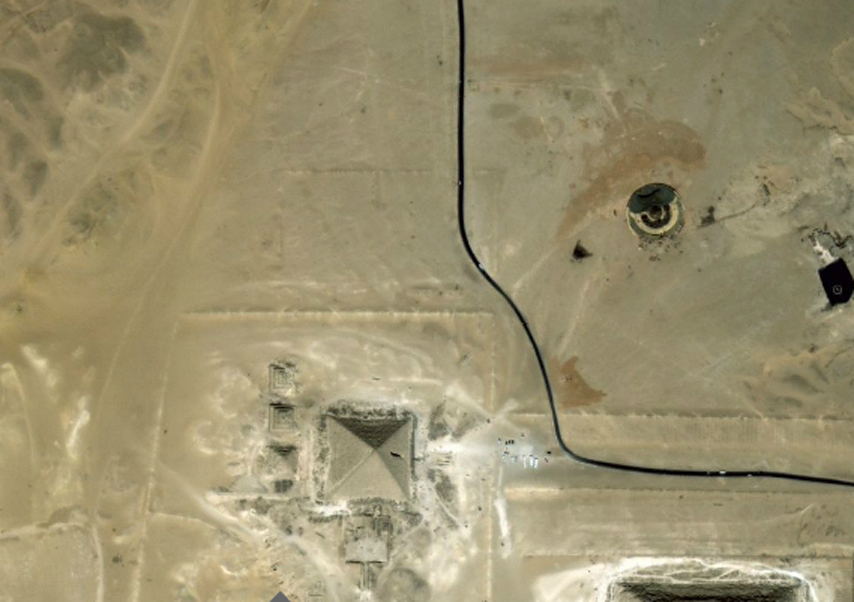

He describes this pyramid here page 120;
Travels in Egypt and Nubia
“The principal pyramids are at the east south east of Gize …..There are four of them, that deserve the greatest attention of the curious,; for tho we see seven or eight others in the neighborhood, they are nothing in comparison to the former. ……. ……..The two most northerly pyramids are the greatest, and have five hundred feet perpendicular height. The two others are much less, but have some particularities, which occasion their being examined and admired.”
Iti s without coating, closed and resembles the others, but without any temple like the first. It has however one particular deserving remark; which is, that its summit is terminated by a single great stone, which seems to have served as a pedestal…the fourth pyramid has been made, upwards above the middle, of a stone more black than the common granite, and at least as hard. Its summit is of a yellowish stone. I shall speak elsewhere of its top, which terminates in a cube. It is, moreover, situated out of the line of the others, being more to thewest…it makes a series with the three others
Other early illustrations also show this fourth pyramid;

The suggestion tends to be dismissed in terms of considering he mistakenly took one of the satellitie pyramids of Menkaure as a fourth pyramid, though he describes the pyramid as made of a stone blacker and harder than granite, whereas the satellite pyramids are all sandstone, also his site plan is of very good quality for the period and positions the fourth pyramid some distance away from that of the third.
He does describe seven or eight lesser pyramid constructions also, which would incorporate the satellite pyramids and show that he did take these into account.
A suggestion is that this fourth pyramid was quarried in the late 1700's, but that there are still stones/ruins in its former locale
Here are some site plans and diagrams that have attempted to incorporate this fourth black pyramid into the greater Giza scheme of things;
www.lostchord.org...
www.lostchord.org...
www.lostchord.org...
There has been a history channel documentary regarding a lost fourth pyramid of Giza, but that was just about the Djedefre pyramid which was never lost anyway, the one that Norden described and placed on his diagram truly has been...
Here's a satellite photo of the area West of G3/Menkaure, some see evidence for an enclosure and square base.

edit on 24-12-2012 by Kantzveldt because: (no reason given)
edit on 24-12-2012 by Kantzveldt because: (no reason
given)
edit on 24-12-2012 by Kantzveldt because: (no reason given)
edit on 24-12-2012 by Kantzveldt because: (no
reason given)
Good thread, thanks. I've never heard of this. Possibly an egyptologist among ATS users can explain this, and pinpoint the exact location rendered in
the drawings and descriptions. An on-site inspection of the area, with maybe a test dig, can ascertain if there is any physical evidence left.
It still surprises me how close the Great Pyramid and the Spinx are to homes and urban-creep. It seems like the local businesses and streets start a quarter of a mile or so from the front of the structures. Almost all the photos we see are from the side which looks out into the sand, kept as "historical sand", no doubt, for the tourists.
It still surprises me how close the Great Pyramid and the Spinx are to homes and urban-creep. It seems like the local businesses and streets start a quarter of a mile or so from the front of the structures. Almost all the photos we see are from the side which looks out into the sand, kept as "historical sand", no doubt, for the tourists.
reply to post by Aleister
I've discussed this previously with those interested in Egyptology, the only conclusion they can come to is as i said, that Norden took a satellite pyramid of G3 as a fourth main pyramid, i'm not sure that's entirely satisfactory though.
There are reports of faced stones in the locale and indications from satellite photography that a construction could have been there.
I've discussed this previously with those interested in Egyptology, the only conclusion they can come to is as i said, that Norden took a satellite pyramid of G3 as a fourth main pyramid, i'm not sure that's entirely satisfactory though.
There are reports of faced stones in the locale and indications from satellite photography that a construction could have been there.
Originally posted by Kantzveldt
reply to post by Aleister
I've discussed this previously with those interested in Egyptology, the only conclusion they can come to is as i said, that Norden took a satellite pyramid of G3 as a fourth main pyramid, i'm not sure that's entirely satisfactory though.
There are reports of faced stones in the locale and indications from satellite photography that a construction could have been there.
Yet as you explained, Norden actually described the pyramid's stones and their color, which doesn't fit with the satellites. Norden went into such detail and personal research that to be totally wrong about this pyramid, both in location and construction-material description, seems, of course, unusual in its own right. Again, thanks for the thread, it certainly raises an interesting mystery.
edit on 24-12-2012 by Aleister because:
edit
like i read
some where in your Op
the stone was most likely re-quarried
and taken away to be used
all this done
by aliens
of-course
some where in your Op
the stone was most likely re-quarried
and taken away to be used
all this done
by aliens
of-course
reply to post by spoonbender
A general rumour come explanation is that it was dismantled by the Freemasons in the 1700's who wanted the cube from it's summit...
reply to post by Aleister
Some consider it relating to the Temple of Sin (the Moon) described by Iamblichus in the Fourth Century.
A general rumour come explanation is that it was dismantled by the Freemasons in the 1700's who wanted the cube from it's summit...
reply to post by Aleister
Some consider it relating to the Temple of Sin (the Moon) described by Iamblichus in the Fourth Century.
edit on 24-12-2012 by Kantzveldt because: (no reason given)
edit on 24-12-2012 by Kantzveldt because: (no reason
given)
reply to post by Kantzveldt
And would it have to be dismantled to get it?
If it was that big, how could they have dismantled it?
Great thread, I have never heard of this.
S&F
But why?
A general rumour come explanation is that it was dismantled by the Freemasons in the 1700's who wanted the cube from it's summit...
And would it have to be dismantled to get it?
If it was that big, how could they have dismantled it?
Great thread, I have never heard of this.
S&F
reply to post by GunzCoty
Hard to say, but i don't think it was dismantled in the 1700's as it was still understood as being there in 1877, unless the author of this didn't realise the Freemasons had made off with it...
Pyramid facts and fancies 1877
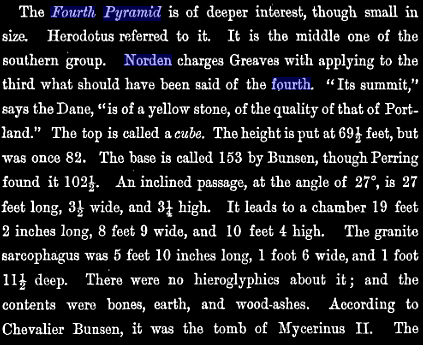
Hard to say, but i don't think it was dismantled in the 1700's as it was still understood as being there in 1877, unless the author of this didn't realise the Freemasons had made off with it...
Pyramid facts and fancies 1877

edit on 24-12-2012 by Kantzveldt because: (no reason given)
reply to post by Kantzveldt
My guess is that it got dismantled like the outer casing of the Giza & co Pyramids. In AD 1300, a massive earthquake loosened many of the outer casing stones, which were then carted away by Bahri Sultan An-Nasir Nasir-ad-Din al-Hasan in 1356 to build mosques and fortresses in nearby Cairo. But maybe they will be destroyed anyway due to certain radical clerics calling for it's destruction and obliteration.
My guess is that it got dismantled like the outer casing of the Giza & co Pyramids. In AD 1300, a massive earthquake loosened many of the outer casing stones, which were then carted away by Bahri Sultan An-Nasir Nasir-ad-Din al-Hasan in 1356 to build mosques and fortresses in nearby Cairo. But maybe they will be destroyed anyway due to certain radical clerics calling for it's destruction and obliteration.
ed
it on 24-12-2012 by TauNorthwolf because: (no reason given)
It makes me wonder.

Could this have been part of it originally? I bet there are plenty of other demolished structures as well.

Could this have been part of it originally? I bet there are plenty of other demolished structures as well.
Very interesting... haven't heard of this before.
Thanks for sharing.
Thanks for sharing.
reply to post by Kantzveldt
Very interesting statements; do you have any literature that I can peruse over about this? Especially, the freemasons bit?
Very interesting statements; do you have any literature that I can peruse over about this? Especially, the freemasons bit?
reply to post by VeritasAequitas
Not really any sort of first or second hand report that i'd consider credible, other than online rumours that the pyramid was dismantled for the hard black stone, that there was a cube on the top, that this is also suggested to have a Masonic eye associate with it.
Nordens description and illustrations are from 1737, when Napoleons expedition was there some 50 or so later there is a perspective drawing which again seems to indicate a fourth pyramid, yet this is not found on the Bonaparte expedition site plan, or subsequently on later plans...
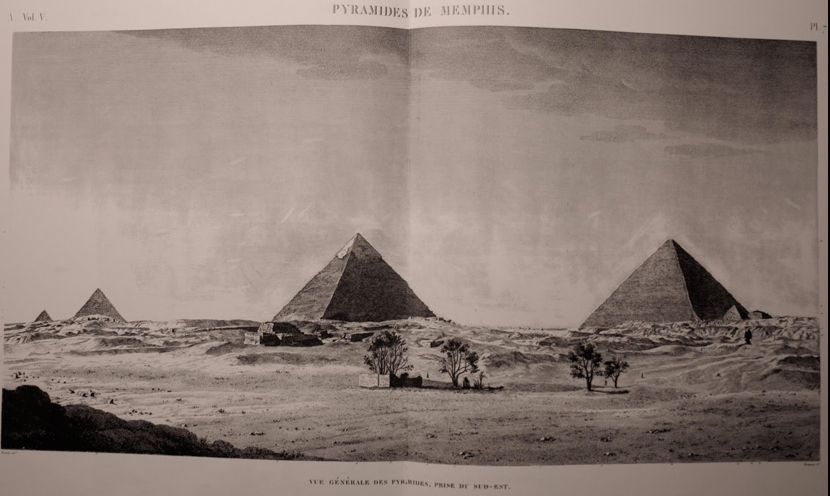
There is the odd illustration from before Norden but these aren't so reliable.
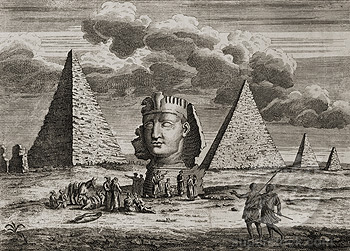
reply to post by TauNorthwolf
I dunno, if there is a supposed Masonic connection then the French of the Bonaparte expedition are the prime suspects...
Not really any sort of first or second hand report that i'd consider credible, other than online rumours that the pyramid was dismantled for the hard black stone, that there was a cube on the top, that this is also suggested to have a Masonic eye associate with it.
Nordens description and illustrations are from 1737, when Napoleons expedition was there some 50 or so later there is a perspective drawing which again seems to indicate a fourth pyramid, yet this is not found on the Bonaparte expedition site plan, or subsequently on later plans...

There is the odd illustration from before Norden but these aren't so reliable.

reply to post by TauNorthwolf
I dunno, if there is a supposed Masonic connection then the French of the Bonaparte expedition are the prime suspects...
edit on 24-12-2012 by
Kantzveldt because: (no reason given)
reply to post by Kantzveldt
I wouldn't consider those a rumor, per say. I think we should take into account the bigger picture.
www.abovetopsecret.com...
I'm not aware of if you have read this thread of mine or not, but you might enjoy it. Couple it with this far older thread...
www.abovetopsecret.com...
And I think you will see why I believe this story holds some merit. Napoleon and Alexander the Great were both initiates of the mystery schools, and would have had access to this information. The 'eye' is a symbol that has permeated every culture of antiquity, so to say that there was a possible pyramid that was deconstructed for the materials and objects they had, I would search very loftily for the answer.
I wouldn't consider those a rumor, per say. I think we should take into account the bigger picture.
www.abovetopsecret.com...
I'm not aware of if you have read this thread of mine or not, but you might enjoy it. Couple it with this far older thread...
www.abovetopsecret.com...
And I think you will see why I believe this story holds some merit. Napoleon and Alexander the Great were both initiates of the mystery schools, and would have had access to this information. The 'eye' is a symbol that has permeated every culture of antiquity, so to say that there was a possible pyramid that was deconstructed for the materials and objects they had, I would search very loftily for the answer.
hi mate
nice thread
i really think this guy is mistaken
ptolimecs said there were three...so did the arabs and herodutus
the ground in that location is not "ready" to take a pyramid
the three are on a limestone bedrock
plus menkaures had a closing wall which stretched out quite far.
many people have dug there, from petri, to hassan, hawass to lehner
the japanese, germans, even the swedes...have all made sonar/magnetic resononce type technology
i just dont see it
but who knows...i`ll do some research
peace
nice thread
i really think this guy is mistaken
ptolimecs said there were three...so did the arabs and herodutus
the ground in that location is not "ready" to take a pyramid
the three are on a limestone bedrock
plus menkaures had a closing wall which stretched out quite far.
many people have dug there, from petri, to hassan, hawass to lehner
the japanese, germans, even the swedes...have all made sonar/magnetic resononce type technology
i just dont see it
but who knows...i`ll do some research
peace
edit on 24-12-2012 by thePharaoh because: (no reason given)
Fantastic op!.. Never heard of this fourth pyramid before.. Thank you for bringing this to my attention.. Off down the rabbit hole I go! lol..
reply to post by thePharaoh
It's interesting that Herodotus mentioned a pyramid supposedly of Menkaure that was of Ethiopian/Black stone up to the half way point, with some confusion over its attribution, he could have got his facts confused there, this pyramid could have been of later period and not Menkaures.
www.gutenberg.org...
There are the traces of an enclosure West of and seperate from that of Menekaure and things do still turn up from beneath the sands such as the satellite pyramid of G1.
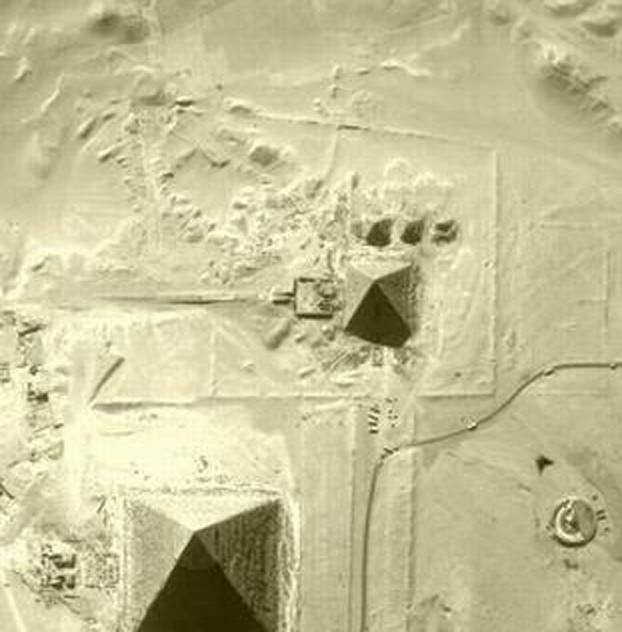
reply to post by VeritasAequitas
Yes the rumours could hold some merit, they certainly didn't worry about taking away the odd obelisk for example...
Thats one rumour source...
www.scribd.com...
It's interesting that Herodotus mentioned a pyramid supposedly of Menkaure that was of Ethiopian/Black stone up to the half way point, with some confusion over its attribution, he could have got his facts confused there, this pyramid could have been of later period and not Menkaures.
This king also left behind him a pyramid, much smaller than that of his father, of a square shape and measuring on each side three hundred feet lacking twenty, built moreover of Ethiopian stone up to half the height. This pyramid some of the Hellenes say was built by the courtesan Rhodopis, not therein speaking rightly: and besides this it is evident to me that they who speak thus do not even know who Rhodopis was, for otherwise they would not have attributed to her the building of a pyramid like this, on which have been spent (so to speak) innumerable thousands of talents: moreover they do not know that Rhodopis flourished in the reign of Amasis, and not in this king's reign; for Rhodopis lived very many years later than the kings who left behind them these pyramids.
www.gutenberg.org...
There are the traces of an enclosure West of and seperate from that of Menekaure and things do still turn up from beneath the sands such as the satellite pyramid of G1.

reply to post by VeritasAequitas
Yes the rumours could hold some merit, they certainly didn't worry about taking away the odd obelisk for example...
Another ancient manuscript recorded an extensive description of curious objects found in the ‘Western’ pyramid. In the 14th Century, some old Arabic and Coptic manuscripts were discovered in a Cairo library, which a particular geographer and historian, Muhammed Taki Al-Makrizi, reproduced in detail into his own work called ‘Hitat’. Thedocuments he found may have been the Tenth Century writings of Masoudi,as there was some indication that he was the original author of the recoveredmanuscripts. In ‘Hitat’ was recorded evidence of the discovery of striking relics in a pyramid at Giza:
Then the builder had put thirty treasury chambers of coloured granite into theWestern Pyramid. They were filled with rich treasures with instruments and picture columns, of precious stones, with equipment of fine iron, like weapons which do not rust, glass you can fold without breaking, with strange charms and lanterns, various kinds of simple and mixed medicines and with deadly poisons…and corpses of the soothsayers, in sarcophagi of black granite, and beside each soothsayer lay a book, in which were written all his magical arts,his life’s story and the works he had accomplished.
The ‘Western Pyramid’ at Giza at that time was the Black Pyramid and the discoveries were things undreamt of in those times…non-corrosive iron and plastics. The ‘thirty treasury chambers’ were not found in today’s Western-most pyramid, Mycinerus, for detailed records revealed that it was opened in1196, thoroughly searched, and its solitary chamber razed
A record of the destruction of the Black Pyramid was found in Masonic literature and revealed that work commenced in 1759 and took ten months to complete. A Scottish faction of the Masonic movement was responsible for its demise that was motivated by the possible discovery of hidden treasure.They took the initiative to dismantle the structure with the support of the English Freemasons who were promised a share of proceeds from any iscovery to finance the expansion their movement. The black stones were sold to help finance the operation and some are seen in buildings in Cairo today.
They measured 2’9” square and were identified as originally being quarried about 16 kilometres SWW of Giza. The square floor-base of stone can still be seen approximately 100 metres up the sandy rise west of Mycinerus’ Pyramid, and identified on the 2001 satellite photo of the GizaPlateau. Dimensions currently available determined that the Black Pyramidwas 159’6” high, and the cube-stone on top was 5’8” in all its measurements.
Thats one rumour source...
www.scribd.com...
edit on 24-12-2012 by Kantzveldt because: (no reason given)
It really is Djedefre's pyramid. It's not part of the Giza Plateau. It sits nearly 5 miles to the west in Abu Rawash. It may have been similar in
size to Khufu's (there's a lot of debate about it, some think it was only a sun temple and much shorter), one thing is known is that the hill it sat
on may have led those first explorer's to view it as 'large as the Great Pyramid'. The base was constructed of darker granite, which could also be
the cause of the 'black pyramid' descriptions. 'Djedefre's pyramid' had been picked at with the stone being carted off since ancient Egyptian
times, the Romans took a large part of it as well, with the base still being carted away even into the 19th C.
Unfortunately old woodcuts and illustrations are prone to misleading 'forced perspective' viewpoints, where Djedefre's pyramid should have been viewed as more distant than as shown.
I believe Jean-Pierre Houdin (the internal spiral ramp theorist) did a computer reconstruction of the site, showing the granite base.
Unfortunately old woodcuts and illustrations are prone to misleading 'forced perspective' viewpoints, where Djedefre's pyramid should have been viewed as more distant than as shown.
I believe Jean-Pierre Houdin (the internal spiral ramp theorist) did a computer reconstruction of the site, showing the granite base.
Great post.. I would also conclude this guy is mistaken.. There would be more trace evidence if a fourth pyramid had been dismantled.. If there is
something behind the theory of Giza pyramids alignment with Orion's belt.. I cant see how a fourth large pyramid would work..
reply to post by Blackmarketeer
I don't think there's any possibility Norden was considering Djedefres pyramid at Abu Rawash to the North as a Giza fourth, from his descriptions and illustrations, clearly the discussion is with regards to the two larger pyramids situated on the North of the Giza plateau and two smaller pyramids to the South.
reply to post by HooHaa
But one doesn't really know what trace remains are under the sand until excavation, and as far as i'm aware none has been undertaken in that area, and as i mentioned elsewhere satellite pyramids have been discovered in recent times at the bases of the major two...
I don't think there's any possibility Norden was considering Djedefres pyramid at Abu Rawash to the North as a Giza fourth, from his descriptions and illustrations, clearly the discussion is with regards to the two larger pyramids situated on the North of the Giza plateau and two smaller pyramids to the South.
reply to post by HooHaa
But one doesn't really know what trace remains are under the sand until excavation, and as far as i'm aware none has been undertaken in that area, and as i mentioned elsewhere satellite pyramids have been discovered in recent times at the bases of the major two...
edit on 24-12-2012 by Kantzveldt because: (no reason given)
new topics
-
Bizarre Labour Party Tic Toc Video Becomes Even More Embarrassing
Regional Politics: 1 hours ago -
Potter to WHU
World Sports: 6 hours ago -
Dr. Demento
Music: 8 hours ago -
The elephant in the room (wearing a hoodie)
US Political Madness: 8 hours ago
top topics
-
The elephant in the room (wearing a hoodie)
US Political Madness: 8 hours ago, 14 flags -
To become president, Zelensky had to learn Ukrainian
Political Conspiracies: 15 hours ago, 9 flags -
Dr. Demento
Music: 8 hours ago, 6 flags -
Bizarre Labour Party Tic Toc Video Becomes Even More Embarrassing
Regional Politics: 1 hours ago, 3 flags -
Potter to WHU
World Sports: 6 hours ago, 2 flags
active topics
-
Bizarre Labour Party Tic Toc Video Becomes Even More Embarrassing
Regional Politics • 3 • : DAVID64 -
The Truth about Migrant Crime in Britain.
Social Issues and Civil Unrest • 43 • : angelchemuel -
The Fight for Election Integrity Continues -- Audits, Criminal Investigations, Legislative Reform
2024 Elections • 4374 • : IndieA -
Los Angeles brush fires latest: 2 blazes threaten structures, prompt evacuations
Mainstream News • 201 • : Flyingclaydisk -
President Carter has passed
Mainstream News • 52 • : xuenchen -
What Comes After January 20th
Mainstream News • 37 • : xuenchen -
Potter to WHU
World Sports • 3 • : gortex -
Post A Funny (T&C Friendly) Pic Part IV: The LOL awakens!
General Chit Chat • 8007 • : underpass61 -
Planned Civil War In Britain May Be Triggered Soon
Social Issues and Civil Unrest • 29 • : AdultMaleHumanUK -
The elephant in the room (wearing a hoodie)
US Political Madness • 19 • : xuenchen
